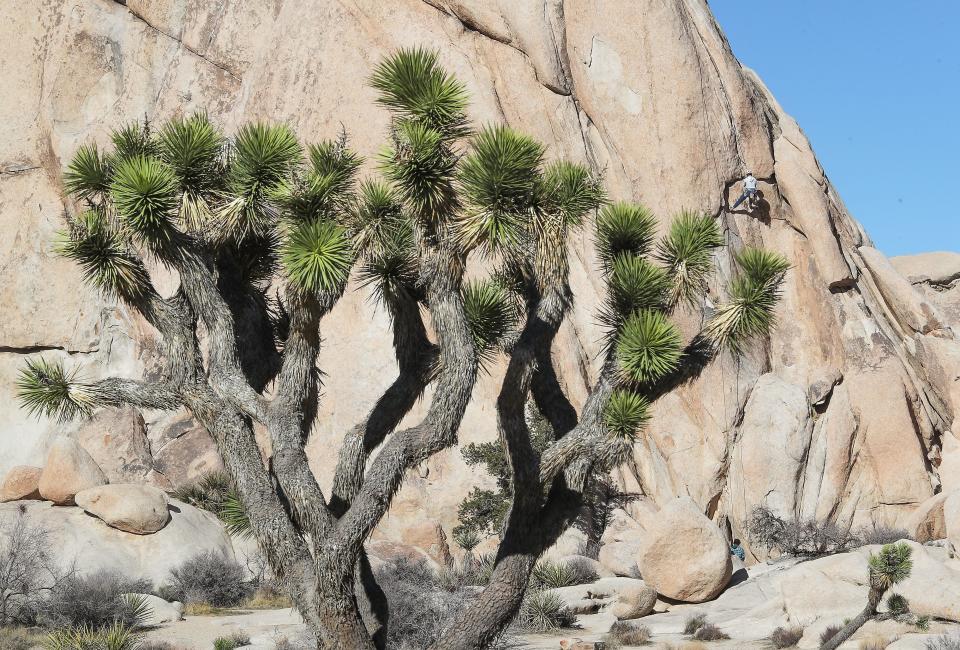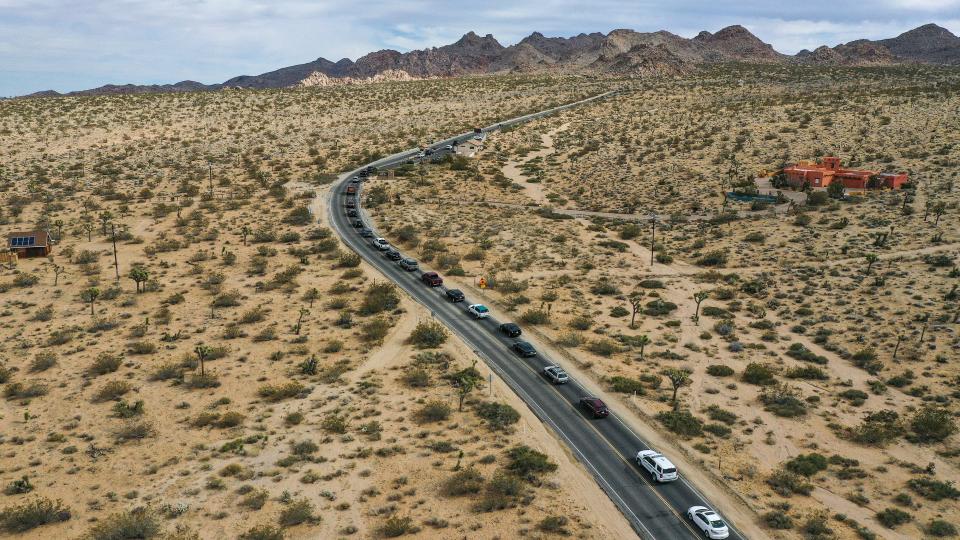Heading to Joshua Tree this spring? Beat the crowds at a lesser-known park entrance
When Park Ranger Hannah Schwalbe started working at Joshua Tree National Park eight years ago, she spent a lot of time communicating where visitors could go to beat the crowds.
“But in those eight years, all of those recommendations have filled up with people,” Schwalbe said.
Attendance at the desert park known for its namesake trees has boomed in the past decade, doubling from roughly 1.5 million in 2015 to over 3 million in 2022. The park's visitation is among the fastest-growing in the national park system. Park visitation typically peaks in March and April ― last year, 431,849 people visited in March and 358,701 in March, compared to between 135,137 and 159,177 visitors each month in the hotter summer season of June through September.
The vast majority of those visitors enter the park through the West Entrance in Joshua Tree, which has become notorious for long lines of cars during the busy season. In 2022, 463,179 vehicles entered the park through the West Entrance, compared with 226,265 vehicles at the North Entrance in Twentynine Palms and 128,205 vehicles at the South Entrance along Interstate 10 about 25 miles east of Indio.
“We get feedback from visitors who waited 40 minutes (at the West Entrance), and are super frustrated, and it’s not as much fun as if they had just driven in from (another entrance),” Schwalbe said.
The park recommends the North Entrance or South Entrance for faster entry. Roads from both of those entrances connect to the West Entrance.

Schwalbe warns, however, that visitors should still “manage their expectations,” as once inside the park there’s no guarantee of parking at popular viewpoints and trailheads, and pretty much all of these popular spots experience large crowds.
If you're coming from the high desert: North Entrance in Twentynine Palms
For visitors coming from the high desert, the North Entrance in Twentynine Palms provides an alternative to the busy West Entrance station. The new Joshua Tree Cultural Center, opened in 2022, is also in Twentynine Palms and now serves as the park’s headquarters and main visitor center, with exhibits, park information, a bookstore, restrooms and water filling stations, and EV charging. (Visitor centers are also available at the other two entrances and at Black Rock Campground).
Like the West Entrance, the North Entrance places you on Park Boulevard and is actually closer to popular rock formations like Split Rock and Skull Rock. But be warned ― while entrance might be easier, you still could face crowds and parking challenges and popular attractions like Split Rock and Skull Rock.
“Going through the North Entrance will probably save you a lot of time and frustration, but it doesn’t really give you that much of an advantage because a lot of those trails could still end up being just as busy,” Schwalbe said, noting that parking lots often fill up at those attractions.
This is why the park recommends that “the best hike may be the one where you can find parking.” It’s a good idea to be flexible, and visit the park prepared for a couple different itinerary options so that you can pivot to a different hike or attraction if one is too busy.
Hikes and attractions within 30 minutes of the North Entrance:
Oasis of Mara: This short half-mile trail is located at the visitor center in Twentynine Palms, and the flat paved loop is considered “the most accessible place to view the California fan palm.” The oasis is also an important cultural site to local tribes, and was settled centuries ago by the Serrano.
Hidden Valley Nature Loop and/or Barker Dam: These two extremely popular trails are near each other in the park. Both trails are easy 1-mile hikes, and can get so crowded that the park closes the parking lots ― an example of a time when the best option between the two hikes is the one that has parking.
Lost Horse Mine: Located off Keys View Road, the Lost Horse Mine trail leads to an abandoned mine that at one time was one of the most successful gold mines in the park. There’s an option to reach the mine via a moderate 4-mile out and back trail, or a more challenging 6.5-mile loop.
Ryan Mountain: A challenging 3-mile hike with 1,050 feet of elevation gain to the summit of Ryan Mountain with expansive views, one of the park’s most popular hikes.
Cholla Cactus Garden: Instead of continuing along Park Boulevard after entering the park from the North Entrance, visitors can also turn onto Pinto Basin Road. About 10 miles south on Pinto Basin Road is the Cholla Cactus Garden, with a very short quarter-mile path through densely-growing cacti.

If you're coming from the Coachella Valley: South Entrance off I-10 near Cottonwood Spring
Visitors occasionally tell park rangers that they went through the “wrong entrance” after entering through the South Entrance because there aren’t any Joshua trees in that region of the park, according to Schwalbe.
But the South Entrance provides the opportunity to see the ecology of the Sonoran Desert, and a drive of about 30 minutes north on Pinto Basin Road from the Cottonwood Visitor Center leads visitors to Joshua trees in the Mojave Desert region of the park. The Cholla Cactus Garden is also about 30 minutes north of the visitor center.
“Part of why Joshua Tree National Park was preserved was because of this transition zone between the two deserts,” Schwalbe said. “Instead of thinking that Cottonwood is the ‘wrong’ entrance because you want to see a Joshua tree, maybe it is actually the right entrance because you really get to experience that transition zone.”
Because the North and West Entrances lead onto Park Boulevard, which goes east to west, while the South Entrance leads to the north-south Pinto Basin Road, the entrance off I-10 provides an opportunity to drive through the southern Sonoran Desert to the northern Mojave Desert. It also can be a more convenient entrance for visitors coming from the Coachella Valley region, especially when wait times at the West Entrance are taken into consideration.
Hikes and attractions near the South Entrance:
Bajada Trail: A short and easy 0.25-mile loop through plants found in the Colorado Desert, a subdivision of the larger Sonoran Desert.
Mastodon Peak: A 3-mile moderate hike with an optional rock scramble to the summit, with a trail that loops past an old gold mine.
Lost Palms Oasis: A challenging 7.5-mile out and back hike that descends into a canyon to a remote fan palm oasis, with a strenuous climb back out of the canyon.
Cottonwood Spring: A very short 10-minute walk to a fan palm oasis with cottonwood trees, known as one of the best spots for birding in the park. (Note: The trailheads for both Lost Palm Oasis and Mastodon Peak are also in the Cottonwood Spring parking area).
Black Rock Canyon
While not one of the three official park entrances, the Black Rock Canyon area in the northwest corner of the park features a campground, a visitor center and several trail options. The road to Black Rock Canyon from Yucca Valley dead-ends at the campground, so you can’t drive to other parts of the park from Black Rock without leaving park boundaries, heading back to Highway 62 and then driving to another entrance. But just 60,290 vehicles entered the park at Black Rock last year, and as soon as you park you’ll see a dense population of large Joshua trees.
However, Schwalbe warns parking lots do fill up at Black Rock, although the crowds aren’t as intense as popular sites like Hidden Valley and Barker Dam.
Trails from Black Rock Canyon:
Hi-View: A 1.3-mile moderate hike from the Black Rock parking area, or three miles from the visitor center, with the trail leading up a steep ridge through Joshua tree forests, with panoramic views of the area.
West Side Trail: A moderate 4.7-mile loop that passes through washes, Joshua tree forests, and over ridges with mountain views.
Panorama Loop: A challenging 6.6-mile loop that leads up a sandy wash before following the ridgeline of the Little San Bernardino Mountains, with the trail leading through both dense Joshua tree forest and pinyon-juniper woodland.
Indian Cove Campground
Like Black Rock, the road to Indian Cove Campground dead-ends at the campground surrounded by towering rock formations, separated from the rest of the park. There are also no Joshua trees on view, but the half-mile Indian Cove Nature Trail provides a tour of the park’s other plants, like Mojave yuccas.
Other tips for visiting during the busy season
Wherever you choose to start your adventure in the park, here are some other tips from the park on visiting during the busy season:
Start your day early, ideally getting to the park before 8 a.m., which is when parking areas can start filling up and traffic starts to back up at the West Entrances.
Save time at the entry kiosk by buying your entrance pass in advance on Recreation.gov.
If you’re camping in the park, try out the hiking opportunities near your campground ― this way you don’t have to worry about finding parking at other spots.
This article originally appeared on Palm Springs Desert Sun: Guide to to beating the crowds at Joshua Tree National Park

